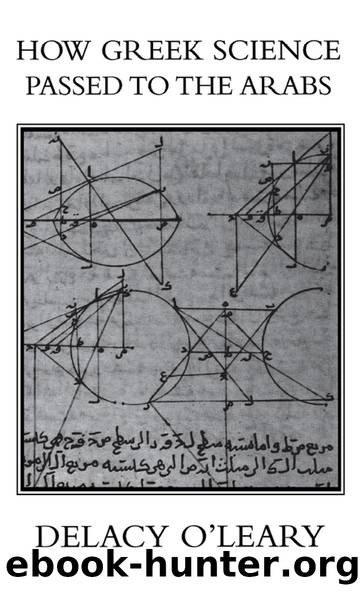How Greek Science Passed On To The Arabs by O'LEARY

Author:O'LEARY [O'LEARY]
Language: eng
Format: epub
Tags: Social Science, Anthropology, General, Regional Studies
ISBN: 9781317847489
Google: FbpACwAAQBAJ
Publisher: Routledge
Published: 2015-12-22T06:00:43+00:00
(2) ALEXANDRIAN SCIENCE IN INDIA
Under the Gupta kings the city of Pataliputra became the home of scientific studies, especially of astronomy and mathematics, both of which show a definitely Greek impress in accordance with contemporary work in the school of Alexandria. The astronomer Aryabhata (born 476â499) taught here and has left a treatise on astronomy with a section dealing with mathematics. Varahamihisa (505â587) compiled a work known as the Pance-Siddhanlika, a compilation of five standard manuals of astronomy which he abridged. One of these five treatises belongs to the pre-scientific age and is of no scientific value, but the other four show the influence of Alexandrian scholarship: two of them bear the non-Indian names of Romank and Paulisa, the latter giving a table based on Claudius Ptolemyâs table of chords. These treatises refer to the Yavanas or Greeks as the great authorities on science. One of the four treatises is the fifth century anonymous Surya Siddhanta or âknowledge by the sunâ, which became a standard manual for Indian astronomers. Brahmagupta (circ. 628) was an astronomer who lived and worked in Ujjain, where there was an observatory. He wrote an astronomical manual called the Brahma Siddhanta in twenty-one chapters, including special sections on arithmetic (Ganitadâhaya) and indeterminate equations (Kutakhadyaka). This work became known to the Arabs during, or a little before, the reign of Harun ar-Rashid and formed the basis of the work which circulated as the Sindhind, a name which represents the Indian Siddhanta.
Under the Sasanid kings of Persia it had been the custom to take and record astronomical observations, no doubt in the first place for astrological purposes, and these records were regularly published as the Zik-i-shatroayar or âroyal tablesâ. The preparation of those tables was not stopped by the Arab conquest, nor were they greatly changed in form, the Persian language was still used and not replaced by Arabic for several centuries, and even then the dates were given with the old Persian months, not the months of the Arabic Muslim year. It is known that there was an observatory at Jundi-Shapur, and no doubt observations were taken there as well as in the Persian observatories, but the whole work was and remained in Persian hands. Then, apparently, the Arabs wanted to understand how these observations were taken and recorded and for that purpose the Sindhind was composed and circulated amongst them. It was the first astronomical manual introduced to the Arabs, and it included not only astronomical information, but also the mathematical material necessary for its use, mostly dealing with spherical trigonometry.
There is a legend, but it is a dubious one, which puts back the translation of the Sindhind to the reign of al-Mansur, the founder of Baghdad. This legend relates that the Arabs conquered Sind (Scind), the area of the lower Indus, in the days of their expansion after the fall of the Persian monarchy, which has a good historical basis. This conquest did not result in a complete occupation of the country, but certain Arab
Download
This site does not store any files on its server. We only index and link to content provided by other sites. Please contact the content providers to delete copyright contents if any and email us, we'll remove relevant links or contents immediately.
The European History Highway: A Guide to Internet Resources by Dennis A. Trinkle Scott A. Merriman(494)
The Seven Wonders of the Ancient World by Michael Denis Higgins(478)
European Security in a Global Context by Thierry Tardy(470)
European Security without the Soviet Union by Stuart Croft Phil Williams(469)
The Routledge companion to Christian ethics by D. Stephen Long Rebekah L. Miles(458)
Hudud Al-'Alam 'The Regions of the World' - a Persian Geography 372 A.H. (982 AD) by V. V. Minorsky & C. E. Bosworth(399)
Gorbachev And His Generals by William C. Green(391)
Get Real with Storytime by Julie Dietzel-Glair & Marianne Crandall Follis(390)
Tibetan Studies in Comparative Perspective by Chih-yu Shih Yu-Wen Chen(385)
Governance, Growth and Global Leadership by Espen Moe(381)
Hyperculture by Byung-Chul Han(378)
CliffsNotes on Fitzgerald's The Great Gatsby by Kate Maurer(360)
The Oxford History of the World by Fernández-Armesto Felipe;(354)
How Languages Are Learned 5th Edition by Patsy M Lightbown;Nina Spada; & Nina Spada(353)
The Egyptian Economy, 1952-2000 by Khalid Ikram(352)
Oral Poetry and Narratives from Central Arabia: The Poetry of Ad-Dindan : A Bedouin Bard in Southern Najd (Studies in Arabic Literature, Vol 17) (English and Arabic Edition) by P. M. Kupershoek P. Marcel Kurpershoek(345)
The Oxford Handbook of the Incas by Sonia Alconini(333)
Europe Contested by Harold James(320)
The Hutchinson Dictionary of Ancient and Medieval Warfare by Peter Connolly John Gillingham John Lazenby(305)
